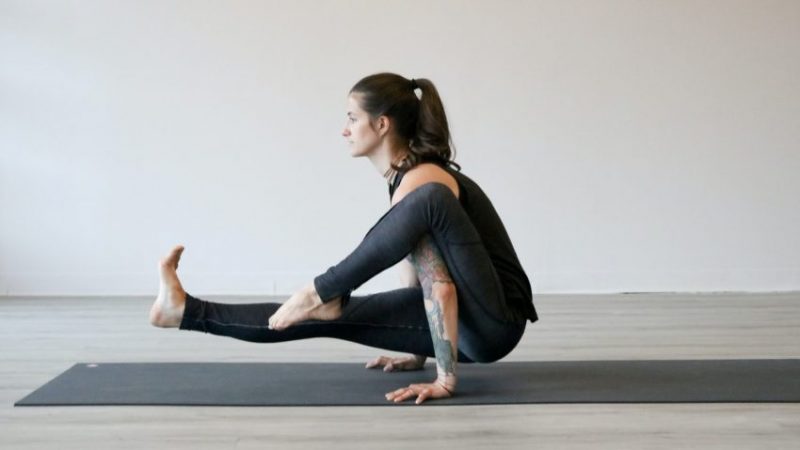30 Fresh Yoga Statistics & Facts You Should Know

Yoga statistics from previous years suggest it’s been gaining increased popularity due to its powerful properties regarding both physical and mental health. Originally, the purpose of yoga was to train the mind’s self-observation and raise awareness of one’s own nature.
This 5,000-year-old type of exercise coming from India engages both the mind as well as the body. There are various yoga styles across the globe, but all of them are based on combining different physical postures, breathing techniques, and meditation.
Is yoga still popular? Are there any proven benefits to practicing this discipline? How’s coronavirus affected yoga? At LoudCloudHealth, we’ve conducted extensive research on this subject and collected some indicative facts and figures about yoga you should know in 2021.
To find out what these are, just keep on reading!
10 Most Intriguing Yoga Stats and Facts
- The demand for yoga equipment skyrocketed by 154% during the pandemic.
- There are 55.05 million yoga practitioners in the US and 38% of them are over 50 years old.
- 54% of yoga practitioners report that yoga helps them release tension.
- 1 in 5 adults claims that the lockdown had a deteriorating influence on their eyesight, making the eye yoga trend highly popular.
- The global yoga market is expected to have a CAGR growth of 9.6% by 2027.
- 1 in 5 Canadians practices some form of yoga.
- Yoga was the most discussed topic on Instagram amidst the pandemic, with a 74% growth in popularity.
- CBD helps you recover faster from muscle strain.
- CBD helps prolong the duration of the so-called “savasana”—feelings of bliss after you leave a yoga class.
- Yoga was a male-only practice until 1937.
Global Facts and Yoga Statistics for 2022
How many people in the world practice yoga, how much is the yoga market worth, and how did the global pandemic affect the market?
1.The average person practicing yoga in the US spends $62,640 during their lifetime on yoga, including classes, workshops, and accessories.
(Eventbrite)
Yoga seems to be quite a flourishing business in the US. Yogis here engage in regular exercise, with the majority (44%) enjoying their classes 2–3 times a week, usually in the morning (34%), while 18% of yogis prefer the evening.
And that’s not all—an average yoga lover is keen on splurging $40 on a special yoga experience.
2. Does yoga really help with anxiety? Yes, it works like a charm.
(NCBI)
Research conducted on 52 women has shown that their symptoms of depression and anxiety decreased dramatically after 12 sessions of hatha yoga. In recent years, yoga has become a widely known method of relaxation. Some yoga instructors even arrange their classes towards combating specific issues, such as anxiety or panic disorder.
But how does yoga actually help us calm down? Yoga postures (asanas), consisting of stretching, lengthening, and muscle balancing, work towards relieving the physical discomforts induced by anxiety. The research recommends it as complementary medicine.
3. The demand for yoga equipment skyrocketed by 154% during the pandemic, based on yoga and coronavirus stats.
(Globe Newswire)
The stay-at-home orders made many people look for alternative ways of getting rid of the stress. Fitness and workout equipment had an immense increase in demand, given that people wanted to stay fit and active while staying at home.
4. Is the yoga industry growing? Absolutely. The global yoga market is expected to have a CAGR growth of 9.6% by 2027.
(Globe Newswire)
That means the yoga industry is estimated to be worth a whopping $66.22 billion by 2027. For comparison’s sake, the yoga industry market was worth $37.46 billion in 2019.
On top of that, there was an increase in demand for online yoga classes due to the global lockdown.
5. Calm was the most downloaded yoga and meditation app in 2020.
(Statista)
Facts about yoga state that Calm had 5.26 million downloads, followed by Headspace: Meditation & Sleep (2.08 million downloads), Meditopia: Meditation Coach (1.89 million downloads), and Yoga Go: Train at Home (1.39 million downloads).
6. 48% of American yogis practice acro yoga and wellness yoga.
(Compare Camp)
A practice based on yoga, Thai massage, and acrobatics, aka acro yoga, is the most popular yoga style among Americans (24%), along with wellness yoga (24% of the surveyed practice it).
17% of American yoga enthusiasts practice power yoga/yoga-pilates/yogalates, while 14% choose Anusara Yoga. Although yoga popularity among Americans is huge, the least popular practice is Jivamukti yoga, with only 2% practitioners.
7. There are 55.05 million yoga practitioners in the US and 38% of them are over 50 years old.
(Statista) (Compare Camp)
You’re never too old to start taking yoga classes. While the highest prevalence (43%) among yoga practitioners is among people aged 30-39, yoga statistics and demographics prove that there are no age limits and that anyone can practice yoga no matter their age.
Complex poses are usually what scares people off, thinking that you have to be a young, trained athlete to do yoga. In fact, everyone can benefit from this ancient practice; there are so many types of it that virtually anyone can find regimes that suit their age, shape, and preferences.
8. Yoga statistics put this practice in the 14th place on the top 20 fitness trends list.
(ACSM’s Health & Fitness Journal)
Although yoga was ranked in seventh place in 2018 and 2019, in 2020, it takes 14th place now, just above licensure for fitness professionals and lifestyle medicine. The most popular fitness trend and the number one spot in 2020 was wearable technology, followed by HIIT and group training.
9. When it comes to yoga in the workplace statistics and instructor fees The lowest rates of a corporate yoga instructor are $50.
(The Yoga Nomads)
On that note, an instructor’s recommendable fee is $75-$200, depending on the number of participants. What do corporate yoga instructors do? They are the teachers that help employees practice yoga in their workplace.
10. The UK accounts for over 10,000 yoga instructors.
(Finder)
Taking everything that was mentioned thus far into account, it comes as no great surprise that yoga statistics for the UK are “operating” in the black.
In total, yoga teachers hold up to 30,000 yoga classes each week; moreover, it has been estimated that there are over 16,400 people employed in the industry in more than 4,900 businesses.
11. 54% of yoga practitioners begin to practice hoping that yoga helps them release tension, yoga statistics indicate.
(Eventbrite)
It is widely known that there’s a connection between yoga and health, and the statistics are very clear about it. More than half of US citizens state that it has a relaxing effect on their nervous system and musculature.
They also reported they were motivated to take up yoga in order to feel happier overall (43%) and that boosts their mental and physical strength (52%).
12. 1 in 5 Canadians practices some form of yoga.
(Leger360)
21% of Canadians (35% of them are people aged 18-34) enjoy doing yoga. Yoga statistics in Canada also show that citizens of Toronto used isolated domes (7 ft tall and 12 ft wide) to practice outdoor yoga and stay in shape during the global pandemic. The classes were held from June 21 to July 31 2020 in front of Hotel X in Toronto.
13. Yoga had a whopping 241% growth among Fitbit users in India.
(TimesNowNews)
Based on the yoga statistics in India, the country had a major growth in Fitbit users that started using meditation, pilates, and yoga during the lockdown, making them the most popular activities amidst the coronavirus pandemic.
14. 1 in 5 adults claims that the lockdown had a deteriorating influence on their eyesight, making the eye yoga trend highly popular.
(Elle)
Eye yoga became increasingly popular during the lockdown, given that a high percentage of people had to switch to remote work and digitalization. Eye yoga includes gentle massages around the eyes, eye-rolling and upward gazing, blinking, palming, nose-tip gazing, etc.
15. 40% of yoga students practiced online yoga before the global pandemic. This number increased by 91% amidst the pandemic.
(Jenni Rawlings)
Yoga statistics worldwide show that the global pandemic made things much harder for yoga students and teachers who were forced to switch to online classes. Naturally, the numbers are even higher amongst yoga teachers. According to one study, only 9% of teachers held online yoga classes before the lockdown. This number grew by 86% due to the closing of the studios.
16. Yoga was the most discussed topic on Instagram during the COVID-19 pandemic, with a 74% growth in popularity.
(Statista)
Yoga witnessed the biggest growth in popularity on Instagram in the UK. Right after yoga, the most popular topics were heath (60%), cooking (48%), and news and politics (42%).
17. CorePower yoga fought coronavirus by offering free online classes.
(303magazine)
One of the biggest yoga studio chains, with more than 200 studios in the US, CorePower, offered free access to various yoga classes to members and nonmembers amidst the pandemic. Their idea was to publish one free class each week through their On-Demand portal. Besides the most popular classes (C1, C2, Sculpt, and Hot Power Fusion), they also offered mediation classes and Livestream classes.
In comparison, based on the CorePower yoga rates, one in-person class costs $26; ten classes cost $218, while the Black Tag Membership is $149 per month.
18. Australia’s pilates and yoga studios industry is worth $739.2 million, and it will witness growth in 2021.
(IBISWorld)
It’s estimated that the market size will have a 3.3% growth in 2021. Take into consideration that this market had the fastest growth, compared to other industries, based on the yoga statistics in Australia. The overall growth rate between 2016 and 2021 is 3%.
19. More than 34,000 people reported injuries caused by yoga practice in 2019.
(OrthoInfo)
While yoga is a good exercise that can help people deal with stress and anxiety, in addition to becoming stronger and more flexible, an incorrect practice might lead to numerous injuries, especially if there are pre-existing musculoskeletal ailments. Therefore, it’s important to take proper precautions to avoid muscle damage.
Yoga injuries statistics show the most common problems include strains and overstretching of the neck, spine, legs, shoulders, and knees.
20. 32% of non-yogis claim that it is, in fact, the lack of their body’s flexibility that holds them back from engaging in this activity.
(Business Mind Body)
This is one of the most widespread misconceptions about yoga. There are special classes adjusted for beginners where they gradually learn how to control their postures by managing their breathing using special techniques; in other words, flexibility comes naturally with time and practice.
Yoga Health Statistics and Cannabis
You’ve probably heard that a number of yogis include cannabis into their regular yoga routine; some even claim that it has become common practice for most yoga practitioners.
While cannabis and yoga probably make for a unique experience, there are some questions we need to answer—for instance—does it offer any special benefits for yogis?
Here’s what cannabis and yoga statistics reveal.
21. There are conflicting beliefs on the very practice of using cannabis along with yoga.
(EverydayPower)
While some claim that yogis should avoid consuming cannabis when practicing—supposedly it has a distracting effect, leading to the complete loss of focus. On the other hand, cannabis is very much present in yoga history. As a matter of fact, the Hindu Lord of Yoga, Lord Shiva, goes under the name as the Lord of Ganja, as that was the deity that gave humanity the gift of cannabis.
22. CBD helps prolong the duration of the so-called “savasana”—feelings of bliss after you leave a yoga class.
(Wanderlust)
Scientific yoga facts prove that when we are feeling blissful, our brain produces the neurotransmitter called Anandamide (fun fact: in Sanskrit, “Ananda” means “bliss”). Since this blissful neurotransmitter is fragile and it stays in our body only temporarily, we are not always blissful.
Research has shown that CBD has the power to “defeat” the enzyme responsible for breaking down Anandamide, thus prolonging the state of bliss, which is produced when you’re practicing yoga as well.
23. Another one in the series of interesting CBD-related yoga facts: CBD can help you with meditation, but it can’t replace regular practice.
(Chicago Tribune)
Combining cannabis and yoga makes for an enjoyable practice. Achieving a meditative state might seem like a simple task, but some people find it hard to just sit still and “do nothing”.
If you have trouble turning off your stream of thought, CBD oil can assist you by slowing down your thought processes, replacing them with some calmer vibes. Still, it’s not a magic wand or potion. Also, the intake of CBD can be different, as well as the effects. People react to CBD in various ways.
24. More cannabis-favorable yoga industry statistics for 2020: CBD helps you recover faster from muscle strain.
(Men’sHealth)
While yoga is supposed to provide a relaxing effect, it’s not as easy as it looks since it includes numerous muscle strengthening postures similar to pushups and planks.
Seeing how it has been scientifically proven that CBD fights inflammation and reduces pain, it may help alleviate the symptoms of muscle strain after an exhausting yoga session.
You choose if you’ll eat a CBD gummy, or some experts even suggest trying a CBD bath bomb.
25. Ayurvedic medicine has opposing views on cannabis, depending on whether it is used as medicine or recreationally.
(Yoga Journal)
As seen from yoga stats, it is confirmed that marijuana has a number of health benefits for treating all kinds of pain, and for instance, alleviating the side effects of cancer treatment.
But otherwise, Ayurveda views marijuana use as problematic. Ayurvedic texts refer to medical cannabis as “nectar,” while its recreational use is not justified and it is referred to as “poison.”
26. Yoga and CBD share many similar health benefits.
(WeSay)
CBD and yoga, combined can help with stress relief, anxiety, sleeping problems, focus and concentration (especially if used before the meditation and yoga sessions), inflammation, appetite reduction, and overall mood improvement.
Very Interesting Facts About Yoga
Here are some interesting facts about this ancient practice with a modern twist.
27. The international yoga day is celebrated on June 21st.
(UN)
In 2014, the United Nations decided to raise awareness about yoga and its health benefits. They decided to make June 21st the international yoga day. This decision was endorsed by 175 UN member states, which was a world record.
The word “yoga” means to “join, unite” and it certainly did so.
28. Yoga fun facts: this 5,000-year-old practice experienced its modern renaissance in the 1920s.
(Vinyasa Yoga School)
If you compare traditional yoga with modern yoga, you’ll notice that the first one doesn’t contain many standing poses since it wasn’t imagined as an exercise tool. The “modern yoga renaissance” started in the 1920s, with Tirumalai Krishnamacharya, aka the “father of modern yoga,” who promoted this practice to a wider audience making it modern.
29. Yoga was a male-only practice until 1937.
(Wanderlust) (Yoga London)
Today there are more female than male yoga practitioners, but it wasn’t always so. Fun facts about yoga tell us Indra Devi (born Eugenie V. Peterson) was the first known woman who was allowed to study traditional yoga.
Not only did she manage to spread yoga throughout the world, but she also taught many famous Hollywood stars like Greta Garbo, Gloria Swanson, and Eva Gabor.
30. Tao Porchon-Lynch was the oldest yoga teacher in the world. She was 101 when she died.
(People)
Tao Porchon-Lynch was born in 1918 in Puducherry, India, where she started to practice yoga when she was only eight years old. Not only was she a great yoga teacher, but a skilled dancer too, which she showed on America’s Got Talent in 2015.
Conclusion
Whatever the case, if you dig a little bit deeper, you will find that yoga is more than just mere relaxation and ridding yourself of worries; it is about transcending all things and reaching a state of complete clairvoyance.
Now, whether you would do this with or without the aid of cannabis, is your own choice. The many potential benefits and advantages are there, as shown by our yoga statistics. Hopefully, they helped present yoga in a clear light and the reasons behind its immense popularity as of today.
FAQs
Is yoga scientifically proven?
Yes, there is currently scientific data proving all the things yoga can do for your mind and body. There’s a plethora of both physical and psychological benefits of yoga — it facilitates relaxation, tones your musculature, keeps you strong, and is even reported to alleviate the symptoms of arthritis.
Additionally, stress statistics show it has a positive effect on your mental health as well—yogis report that it helps them find their peace of mind whenever they feel stressed out.
What are the disadvantages of yoga?
Yoga can have a lot of benefits; however, there are a few downsides you need to keep in mind.
First of all, not all age groups will be able to perform certain poses. Some poses are not suitable for older people, and they might find it difficult to perform. Secondly, yoga is not recommended for disabled people and pregnant women. And lastly, if not performed correctly, yoga can cause injuries.
Therefore, it’s important to find a suitable guide and a qualified yoga teacher.
How many times a week should I do yoga?
For absolute beginners, even once a week suffice. However, the optimal rate is 3-5 times per week. Newbies to this practice should start with 2-3 hours per session to get used to the poses and stretches. On that note, you can increase the number of hours and sessions over time.
Bear in mind that only you can decide on this matter; nobody knows your body better than you do.
Where is yoga most popular in the world?
India’s Rishikesh, aka the yoga capital of the world, is the most popular place for yoga. It’s the home of numerous yoga ashrams. This city is a host of the annual International Yoga Festival, allowing people from all over the world to practice yoga together. The Indonesian island of Bali holds the second place, with over 600 yoga teaching academies.
The list of countries where yoga is popular also includes France, Portugal, Germany, Greece, the US, Italy, the UK, and more.
Why has yoga become so popular?
Well, apart from the reported physical benefits, yoga can also make you feel less stressed. In fact, 80% of yoga practitioners believe it can help them deal with stress, and 1 in 3 believe it makes them happier. What’s more, 4 in 10 yoga practitioners report switching to a more healthy diet.
How big is the yoga industry?
The yoga market was worth $37.46 billion in 2019, and it’s projected to reach a CAGR growth of 9.6%, i.e., it should be worth $66.22 billion by 2027. On top of that, there was an increase in online yoga class demands amidst the global pandemic.
Given that it’s one of the cheapest practices in the sense that it doesn’t require complicated, expensive equipment, yoga statistics show it was one of the most popular practices among people during the lockdown.





